And Never Let Her Go: Thomas Capano: The Deadly Seducer Read online
Page 4
This was the background that Marguerite and Louis came from, and their values were similar. Their lives were wrapped around St. Anthony’s Church, and they expected that they would have to work hard to get anywhere in the world. Marguerite was slender and very pretty, with dark-fringed blue eyes and soft hair that she wore short and feathered around her face. The couple was barely twenty, and poor, when they married. Deeply devout Catholics, they looked forward to having as many children as God sent them.
Their first child was a girl: Marian, born July 29, 1944. She was a pretty little thing with curly dark hair. Five years later came Thomas Joseph—named for his two grandfathers—born October 11, 1949. Louis Jr. was born two years after that, on October 24, 1951, and a year to the day later, Joseph. Although all of the Capano boys had October birthdays, they looked nothing alike, nor were their personalities similar. They were, however, very close to one another.
In the forties, Louis and Marguerite lived on the Du Pont Highway—Route 13. It wasn’t a very good neighborhood, but it was what they could afford at the time. When Marian was three, Louis Sr. went into business with Emilio Capaldi. They formed the Consolidated Construction Company and specialized in store and office remodeling and renovations. The men would remain friends for life, a friendship forged working side by side for long hours. Lou Capano was an excellent finish carpenter.
Lou and Marguerite raised their family in the modest little house out on Route 13, and Lou’s first office was a small place, but that all changed with the tremendous demand for housing after World War II. Consolidated Construction became Capaldi and Capano, and they began to build homes for the influx of young professionals who flocked to Wilmington to work for the DuPont company. Emilio did the architectural drawings and planned the subdivisions, and Lou oversaw the jobs.
Capaldi and Capano built good, solid houses, and almost overnight new neighborhoods sprang up in the north end of Wilmington. They were all built by the two Italian contractors, but they had English-sounding names like Galewood, Boulder Brook, Canterbury Hills, and Westminster.
Lou had the callused hands and thick forearms of a real builder. There were many who told him he could show a lot more profit if he wasn’t so determined to deliver top quality. But at heart he was still a custom builder, an artist with wood and stone. He could not bring himself to cut corners even if he was the only one who would know that the floor joists were close enough together to meet the highest standard or that the studs behind the walls were the best grade.
“I remember seeing Louis Sr. when I was thirteen,” a longtime Wilmington resident recalled. “My dad hired him to build our house, and my dad wasn’t that easy to please. He’d gone to meet Mr. Capano and the architect. He came home and he said—talking about Mr. Capano—‘He’s very disarming, isn’t he?’ and that was my father’s way of saying that he was going to hire him.
“Mr. Capano built us this big white house, but there was something my father wanted him to fix—the curve of our stairway wasn’t quite right. He came back a couple of times—himself—to be sure it was exactly what my father wanted. I remember Mr. Capano standing in our yard, and he wore a trench coat. And he did have something—this presence about him. That house is still in good shape.”
Lou continued to strengthen his reputation as a builder to be trusted. The “DuPonters” poured into Wilmington, and they needed more and more houses. Lou’s banker summed up why he was so respected: “He was the kind of a builder who didn’t play games—he told bankers the truth. If he was having troubles he would tell you. That was a nice thing for a banker, since so many builders tried to hide things and hoped they’d go away. But Lou Capano built the houses too good—and the building business is too cyclical.”
Lou made deals worth hundreds of thousands of dollars on a handshake—and he was never known to go back on his word. Any house with his name on it as the builder automatically jumped a few thousand dollars in value. He drove himself, chain-smoking all the time. He expected his boys to work just as hard, and he was a strong patriarch in a typical Italian family. All three sons did their turn with a shovel and pickax working summers for their father. They dug ditches, moved bricks, and drove trucks. Their father wanted them to understand the construction business from the bottom up. Even so, they never knew the hard times that he had. The Capano children grew up in the magnificent gray-stone Colonial mansion Lou built for them on Weldin Road in Brandywine Hundred. It had gabled windows and bay windows, sunrooms, breezeways, and a huge garage. A circular driveway cut a swath through holly, fir, and maple trees, and it was landscaped with shrubs and flowers.
Marguerite moved with seeming ease from the little house to the mansion, although the change was akin to going from a furnished room to a penthouse. She never worked outside the home, and she knew nothing at all about business affairs or keeping books. She was a wife and a mother. But she was a strong woman who felt her husband and children could do no wrong. “She was one tough cookie,” a woman who knew her then remarked.
When the boys were elementary school age, Joey Capano once made an anti-Semitic remark to a Jewish boy, and his mother called Marguerite to complain, asking her to intervene and reprimand Joey. Marguerite refused, saying, “Well, my kids get called wops and guineas. He should toughen up.”
Lou and Marguerite’s boys didn’t resemble one another in looks or personality, but Tommy, Louie, and Joey all had dark hair and their father’s charisma. Tommy was clearly the most scholastically adept. His sister, Marian, remembered fondly, “I can still picture him reading books at his little desk in his little room.” Tommy was also the son who did the dishes and washed the pots and pans without complaint. Louie was charming and funny, and Joey was arguably the best looking and the rowdiest.
The Capanos loved kids, including the neighborhood kids. Whether in the old neighborhood or on Weldin Road, their home was open to children. When the sultry summer months suffused Wilmington with a blanket of heat and even the tomatoes and peppers growing in front yards drooped, anyone who could afford to headed for the ocean beaches on the Delaware coast, or to the little offshore islands of southern New Jersey, which rested in the Atlantic Ocean as if some giant chef had spattered bits of pancake batter on a hot griddle. In Delaware, vacationers called it “going to the beach”; in Jersey, it was “going down the shore.”
Marguerite and Lou chose the Jersey shore. It was a two-and-a-half-hour drive from Wilmington across the Delaware River and then through a series of little towns in New Jersey. Lou bought a duplex in Wildwood. They rented out the lower floor and kept the upstairs for family vacations. They took their children, their relatives, and any neighbor child who wanted to go.
“It was a madhouse,” a onetime tagalong remembered. “Kids and dogs, sleeping on mattresses, running in and out. It was like the old days on Seventh Street. Marguerite was cooking lots of Italian food, and she waited on everyone. Lou was just sitting there reading the paper as if everybody wasn’t running around him. He was very calm, and very kind to all of us.”
Marguerite and Lou were almost forty in the summer of 1962, Marian was in college, Tommy was in the eighth grade, Louie in the sixth, and their youngest son, Joey, was ten, when Marguerite found she was pregnant. This baby was a surprise, and somewhat worrisome because she had never had easy pregnancies and she was a decade past her last baby. She was confined to bed throughout this pregnancy, and her boys, especially Tommy, waited on her and did the chores she could not.
But Gerard was born healthy on May 25, 1963, and Marguerite recovered to full health. Still, it was to be a bad year for the family. Lou, only forty, had a serious heart attack and had to stay in bed for weeks. Gerard—Gerry—was taken care of as much by his older brothers, and his sister when she was home, as he was by his parents. Not surprisingly, he was soon spoiled rotten.
“Gerry had these long golden curls,” a neighbor remembered, “and no one in his family could bring themselves to cut his hair for years. He really was a beautiful
baby and he was hard to resist. Down at the shore the summer he was three, he went around saying to everyone, ‘You’re a pain in the ass!’ and the family all just laughed at him. Nobody scolded him.”
Before he went to school, they cut Gerard’s long yellow curls, but he would always have a soft, baby face—even as a grown man.
LOU CAPANO recovered from his heart attack and went back to chain-smoking and working long hours as a builder. He and Emilio Capaldi dissolved their partnership, but they remained friends for life. High on Lou’s agenda was the education of his sons. His own education had been rudimentary at best, and even when he became a financial success, he was intimidated by men with college degrees. He vowed that his children would go to the best schools, although it was sometimes a financial crunch for him as the real estate market rose and fell.
They all attended Catholic schools, just as the family attended St. Anthony’s Church. It was the same church and the same priest, Father Robert Balducelli—Father Roberto—as it had been when Marguerite and Lou were first married; but the Capano sons went to St. Edmond’s Academy for Boys during their elementary school years, and from the ninth grade on, Tommy and Louie attended Archmere Academy, a Catholic prep school in Claymont, Delaware, a dozen miles north of Wilmington.
The forty-eight-acre estate that would become Archmere was once home to John J. Raskob, at various times chairman of the board of General Motors, secretary to Pierre S. du Pont, and vice president in charge of finances for the DuPont company. He also built the Empire State Building. He lived at Archmere with his wife, Helen Springer Green, and their twelve children from 1910 until 1931. Not much removed by distance from Seventh Street and Rodney, where the Capanos, Rizzos, Moglionis, and their friends lived, it was like another planet in ambiance. Archmere was plush and private and absolutely perfect.
The twenties were an untroubled decade along the Delaware River; it was the place to reside—Scott and Zelda Fitzgerald lived just down the river from the Raskobs, and between one estate or the other, there was a constant flood of famous visitors. But as John Raskob became more well known and word of his wealth spread, he worried. The rest of the nation was caught in the Great Depression and feelings ran high. In 1931, Raskob was gravely concerned when a kidnapping threat to one of his children was conveyed to him. His children meant more to him than his great wealth, and he moved away from Archmere, leaving behind its Italianate Renaissance mansion—the Patio—and Manor Hall, where the servants lived. The Raskobs had their memories of parties, meetings with the Democratic National Committee, and visits from presidential nominee Governor Al Smith, for whom Raskob was campaign manager. When the Lindberghs’ baby was kidnapped the next March, the Raskobs knew they had done the right thing in moving to a less accessible home.
A year later, the abbot of the Norbertine order of Catholic priests purchased Archmere for $300,000 and opened a boys’ prep school with an enrollment of twenty-two students. Archmere expanded its student body and built more and more buildings, always adhering to its motto, Pietate et Scientia (By Holiness and Knowledge).
And so in the sixties the sons of a once-poor carpenter attended Archmere. Tommy was not only a superior student, he was student council president and a star on Archmere’s football team. He was undeniably his parents’ favorite child, quiet and conservative like his father, hardworking, and disciplined. Father Thomas A. Hagendorf, one of his teachers at Archmere Academy, recalled that “Thomas was a shining star.”
Tommy always seemed to do everything first—and best—but Louie, two years younger, didn’t resent his big brother. Rather, he idolized him. Tommy was good to him, someone he could always go to for advice. They each had distinctive personalities and a different circle of friends. Louie was the charmer who could work a roomful of strangers and leave with a bunch of new friends. He already had the attributes that would one day give him the Midas touch.
The priests at Archmere were nervous about the effect the sixties would have on the adolescent boys they supervised. One headmaster wrote with relief, “Through the anxious, emotional, and intellectual years of the sixties, Archmere kept to a sane course, adhering to its philosophy of teaching religious, academic, and moral fundamentals, while at the same time improving the quality of its course offerings.”
The Capanos had always invited their parish priests, especially their beloved Father Roberto Balducelli, who had been pastor at St. Anthony’s for twenty-five years, home for dinner or for weekends at the shore, and the Archmere priests were brought into the family, too.
As always, the boys’ friends were welcome in the Capano home. Blair Mahoney, whose father was Dave Mahoney of the Four Aces, the top-ten vocal group whose records swept America in the early to mid-fifties, was one of Tom’s best friends. While the Four Aces were traveling the country singing “Tell Me Why” and “Stranger in Paradise,” Blair virtually lived with the Capanos during summers at Wildwood, and in Wilmington, too, when he and Tommy went to Archmere. “Mrs. Capano was like a mother to me,” Mahoney recalled. “I wasn’t the easiest young man to manage. She did great keeping me in line.”
Although Archmere was then strictly a school for young men, coeducational dances were held there, and an invitation to attend was much to be desired by teenage girls in Delaware and New Jersey. Tommy was especially close to his cousin Donna, his aunt Mary Rizzo’s daughter, and he often invited her and her girlfriends to the Archmere dances. The hall where the dances were held was fairly prosaic and it was the cachet of Archmere that drew them. That, and Tommy Capano.
“He was so handsome then,” Donna’s friend Emily Hensel remembered. “He was just about anything a teenaged girl could want—good looking, popular, and a football star. I can close my eyes even today and see Tommy dancing on the floor. For some reason, the song I hear in my head when I think of Tommy is ‘Time Won’t Let Me,’ by the Outsiders. It was his song—at least in my own memory.”
Tommy was always known as the good brother, the dependable brother. Marguerite and Lou were proud of all of their boys, but Tommy was the one they could count on. Marian was in college, studying to be a psychologist, but she was only a girl, after all, and it was to his sons that Lou looked for his immortality.
For some reason, perhaps by their own private agreement, Tommy always drove a black sports car and Louie had a white one. Everyone who lived in Brandywine Hundred hung out at the Charcoal Pit on the Concord Pike. It was a hamburger joint not unlike any other teenage hangout in America, but the charcoal-grilled burgers and the fancy ice cream floats, and most of all the ambiance, packed it every night and especially on weekends. When the Capano boys drove up in their new cars, young hearts beat a little faster. The Capano brothers cruised the boardwalk and the strip at the shore when the family summered in Wildwood, so tanned and good looking and sure of themselves.
In prep school, Tommy seemed unattainable for most girls. He was polite and friendly enough, but it seemed a given that he would choose a girl that everyone wanted. “I remember him in his black convertible,” a Wilmington woman recalled. “He was dating this really rich girl—beautiful, of course—but I can’t even remember her name. She lived in a house that was basically Tara, with the white pillars and all. Tommy’s car would be parked out in front. I knew then that he was kind of—well, when you were around Tommy, you thought you were in the presence of a god. None of the rest of us could ever hope to actually date him.”
Tommy Capano was just under six feet tall, not as handsome as Joey or as dynamic as Louie, but he did have the full lips and classic nose of an Italian statue. More than that, he was such a nice guy with a wonderful soft voice. “When Tommy talked to you,” a woman who met him at a party said, “you had the feeling that you were the only person in the room. He focused entirely on you—no eyes darting around the room or over your shoulder.”
Even the guys his own age who were jealous of Tommy because of his wealth and popularity, and because his father had bought him a sports car, admitted that he had ea
rned his popularity. No one ever said he was less than kind to everyone. He was the leader, the one who would keep them together for reunions for decades to come. One of Tommy’s classmates was a diabetic who sometimes went into a coma. It was Tommy who kept the syringe of insulin just in case, and Tommy who didn’t hesitate to use it to bring his friend around.
“You could literally trust him with your life,” a man who graduated from Archmere with Tom said. “He was always more mature than we were.”
Joey, three years younger than Tommy and a year younger than Louie, attended Brandywine High School rather than Archmere. He was the huskiest of the brothers and the least academically inclined, but he was an outstanding wrestler in high school, competing in the 185-pound class.
During the time that his big brothers were at Archmere and Brandywine High, Gerry Capano was still a little kid, in kindergarten when Tommy was about to graduate from Archmere in 1967. Tommy, Louie, and Joey were like three extra fathers to him, and he adored them. He still got pretty much everything he asked for. Nobody saw any reason not to spoil Gerry.
Tom graduated from Archmere in 1967 and was accepted at Boston College. Louie, graduating in 1970, went to the University of Delaware in Newark. Joey went a year after that. Tom would remember his little brother, Gerry, sitting on his chest and begging him not to go away to college. It was a wrench for him, too; he considered himself as much Gerry’s father as Lou was.
Chapter Three
ROBERT FAHEY SR. failed to get himself together when he was widowed. “After my mom died,” Brian remembered, “the family situation deteriorated—slowly at first, but completely after a while. My father eventually stopped working, and he had been a heavy drinker beforehand, but became an even more intense alcoholic.”
Fahey’s own insurance and pension plans ran out. And the commissions due on policies he had written in the past slowed to a trickle, then stopped completely. The Faheys had done so much to help others before their world collapsed, and now, without asking questions or pointing a finger of blame, friends stepped in and quietly paid their electric and phone bills.

 Too Late to Say Goodbye: A True Story of Murder and Betrayal
Too Late to Say Goodbye: A True Story of Murder and Betrayal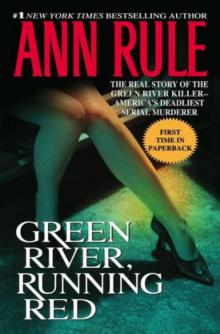 Green River, Running Red
Green River, Running Red Bitter Harvest
Bitter Harvest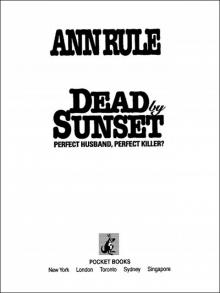 Dead by Sunset: Perfect Husband, Perfect Killer?
Dead by Sunset: Perfect Husband, Perfect Killer?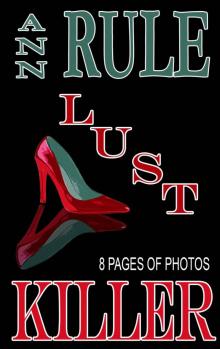 Lust Killer
Lust Killer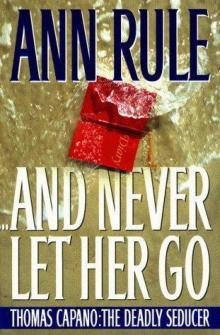 And Never Let Her Go: Thomas Capano: The Deadly Seducer
And Never Let Her Go: Thomas Capano: The Deadly Seducer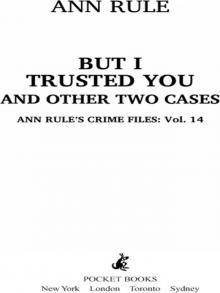 But I Trusted You and Other True Cases
But I Trusted You and Other True Cases Smoke, Mirrors, and Murder and Other True Cases
Smoke, Mirrors, and Murder and Other True Cases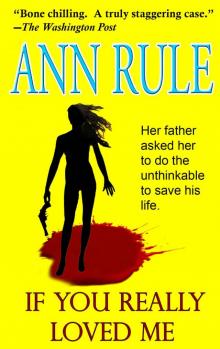 If You Really Loved Me
If You Really Loved Me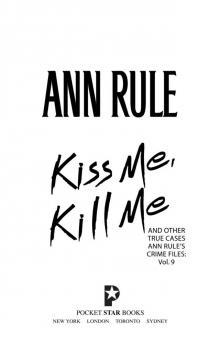 Kiss Me, Kill Me and Other True Cases
Kiss Me, Kill Me and Other True Cases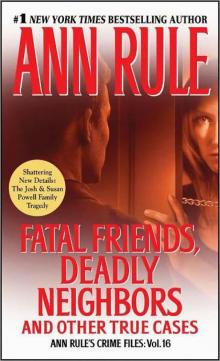 Fatal Friends, Deadly Neighbors and Other True Cases
Fatal Friends, Deadly Neighbors and Other True Cases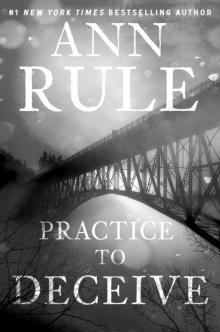 Practice to Deceive
Practice to Deceive Mortal Danger and Other True Cases
Mortal Danger and Other True Cases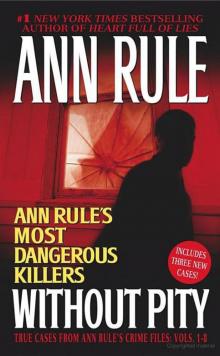 Without Pity: Ann Rule's Most Dangerous Killers
Without Pity: Ann Rule's Most Dangerous Killers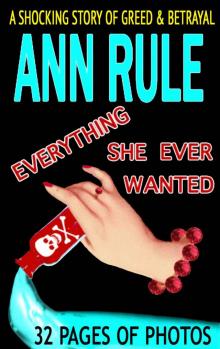 Everything She Ever Wanted
Everything She Ever Wanted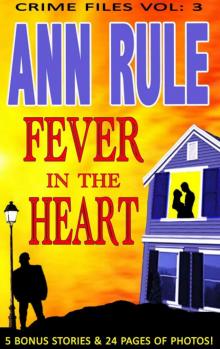 A Fever in the Heart and Other True Cases
A Fever in the Heart and Other True Cases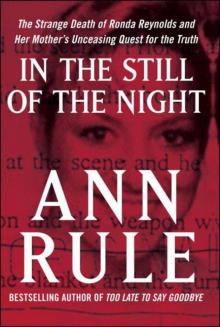 In the Still of the Night
In the Still of the Night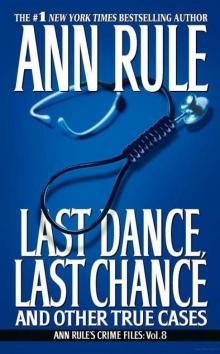 LAST DANCE, LAST CHANCE - and Other True Cases
LAST DANCE, LAST CHANCE - and Other True Cases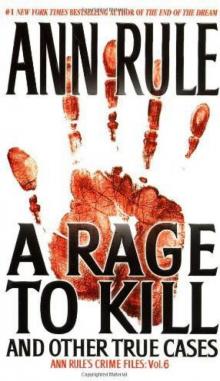 A Rage to Kill
A Rage to Kill The I-5 Killer
The I-5 Killer The Stranger Beside Me
The Stranger Beside Me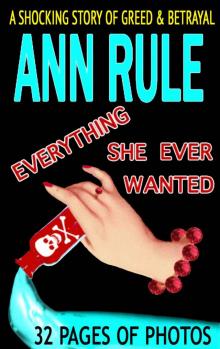 Everything She Ever Wanted: A True Story of Obsessive Love, Murder, and Betrayal
Everything She Ever Wanted: A True Story of Obsessive Love, Murder, and Betrayal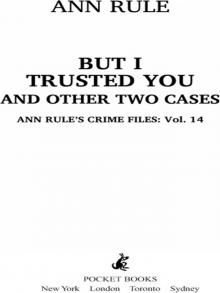 But I Trusted You
But I Trusted You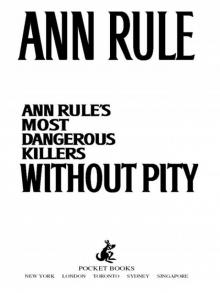 Without Pity
Without Pity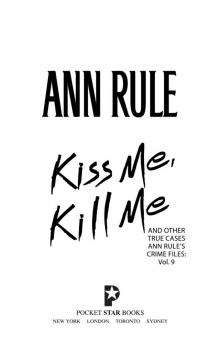 Kiss Me, Kill Me
Kiss Me, Kill Me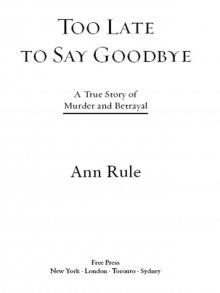 Too Late to Say Goodbye
Too Late to Say Goodbye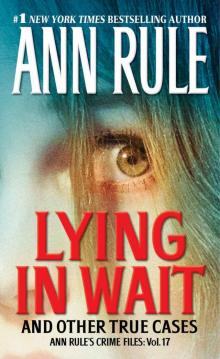 Lying in Wait
Lying in Wait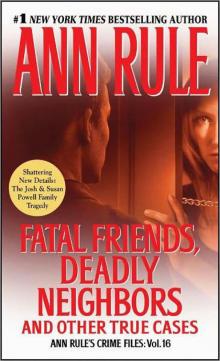 Fatal Friends, Deadly Neighbors
Fatal Friends, Deadly Neighbors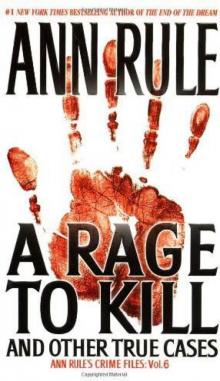 A Rage to Kill: And Other True Cases
A Rage to Kill: And Other True Cases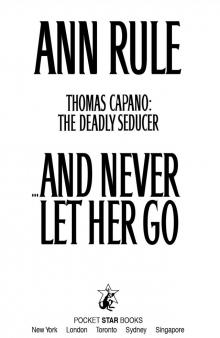 And Never Let Her Go
And Never Let Her Go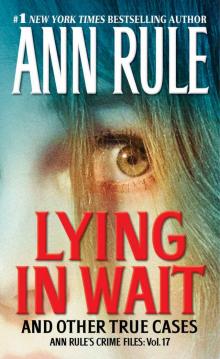 Lying in Wait Ann Rule's Crime Files Vol.17
Lying in Wait Ann Rule's Crime Files Vol.17 Blood Secrets: Chronicles of a Crime Scene Reconstructionist
Blood Secrets: Chronicles of a Crime Scene Reconstructionist No Regrets
No Regrets Mortal Danger
Mortal Danger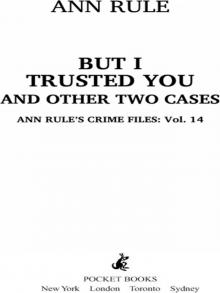 But I Trusted You: Ann Rule's Crime Files #14
But I Trusted You: Ann Rule's Crime Files #14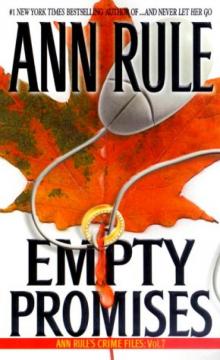 Empty Promises
Empty Promises Dead by Sunset
Dead by Sunset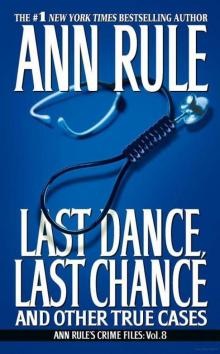 Last Dance, Last Chance
Last Dance, Last Chance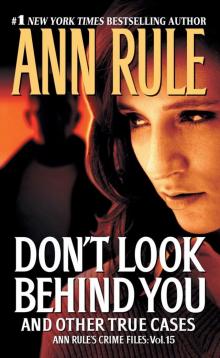 Don't Look Behind You
Don't Look Behind You